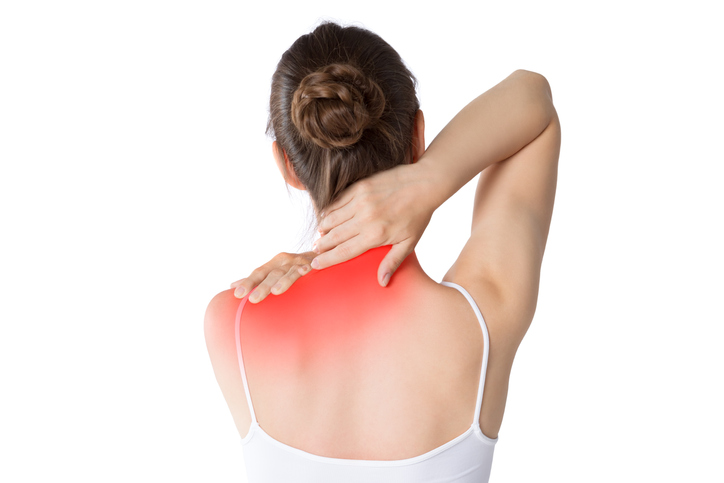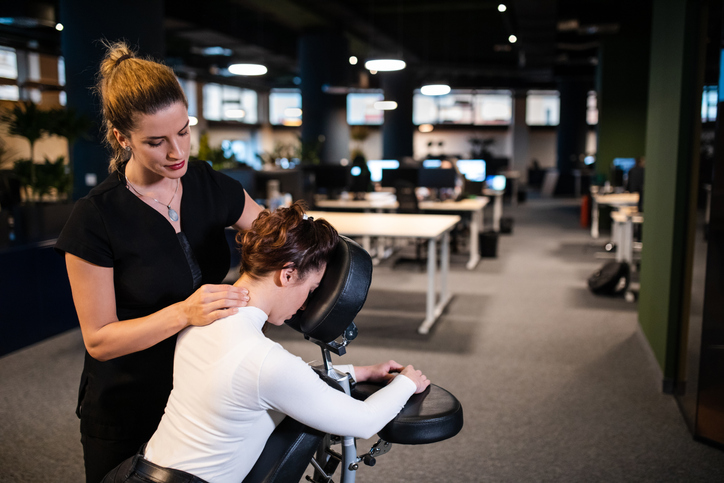Pain
Causes of Neck Pain

Neck anatomy
The neck acts as a bridge between the head and the torso. It is located between the mandible (jaw bone) and clavicle (collarbone). The neck contains numerous essential anatomical structures. It holds the uppermost portion of the spinal cord, including the first 7 vertebrae (the cervical vertebrae). It is also composed of various muscles, ligaments and tendons. Visit Medscape for more details about the anatomy of the neck.
Neck pain, or cervicalgia, is a common ailment. Fifty percent of individuals in the United States will experience neck pain at some point in their lives, and between 20% and 70% of those individuals will experience neck pain that interferes with daily activities. Neck pain has various causes, including the following:
- Ankylosing spondylitis
Ankylosing spondylitis is a specific type of arthritis that is characterized by inflammation, stiffness and pain in the joints of the spine. It primarily affects the lower portion of the spine, but as the condition progresses, it can affect the neck. Symptoms range from aching pain to burning sensations in the back and/or neck, fatigue, loss of spinal mobility, pain that worsens with rest, sensitivity to light, pain in other joints, and chest pain. - Arthritis
Both rheumatoid arthritis and osteoarthritis can affect the cervical vertebrae/cervical spine. Symptoms of rheumatoid arthritis that affects the cervical spine include neck pain, swelling, stiffness, and loss of mobility. Symptoms of osteoarthritis in the cervical spine include neck pain that gradually worsens. Pain is typically more intense first thing in the morning or at the end of the day. Symptoms also include tenderness when the neck is pressed, pain that radiates to the shoulder, and headaches. - Cervical dystonia
Cervical dystonia is a rare disorder in which the neck muscles involuntarily contract, causing the head to twist or turn to one side. It may also cause the head to uncontrollably tilt forward and back. The head may twist in the following ways: chin toward shoulder, ear toward shoulder, chin up, and chin down. Other symptoms include neck pain that radiates to the shoulders and headaches. - Cervical fracture
A cervical fracture involves a crack, break or fracture in one of the cervical vertebrae. It most commonly occurs as a result of high-energy trauma, such as a car or sports-related accident. Symptoms include severe neck pain, swelling of tissue around the fracture, and tenderness or numbness at the site of the fracture. - Cervical kyphosis
Otherwise known as military neck, cervical kyphosis is an abnormal curvature of the neck — either straight (like standing at attention) or bent backward. Symptoms include neck pain, pain in the extremities, stiffness, decreased range of motion, headaches, muscle weakness, spinal deformity, coordination issues, bladder and bowel problems, and paralysis. - Cervical myelopathy
Cervical myelopathy occurs when the spinal cord is compressed in the cervical area. Symptoms include neck pain and stiffness, tingling, numbness, weakness, hand clumsiness, balance problems and difficulty walking. - Cervical radiculopathy
Otherwise known as a pinched nerve in the neck, cervical radiculopathy occurs when a nerve root in a cervical vertebra is inflamed or damaged. Symptoms include neck pain, tingling, or numbness that may radiate into the arm and fingers, altered reflexes, and weakness. - Cervicogenic headache
A cervicogenic headache is actually referred neck pain. Symptoms include neck pain, headache, reduced flexibility of the neck, eye swelling and blurry vision. - Degenerative disc disease
Degenerative disc disease involves pain due to one or more of the discs between the vertebrae drying out, losing their flexibility, elasticity, and the ability to absorb shock. When this occurs in the neck, symptoms include neck pain that may radiate down the shoulders, arms and hands; muscle tension; muscle spasms; and pain that worsens when sitting, bending, lifting or twisting. - Herniated disc
As a disc naturally degenerates with age, the soft jelly-like center of the disc (nucleus) can herniate or tear through the tough, rubbery exterior. This is referred to as a herniated disc. Symptoms include neck pain; tingling or numbness in the shoulder, arm and hand; and weakness of the arm and hand. - Idiopathic carotidynia
Otherwise known as Fay Syndrome, idiopathic carotidynia is a rare atypical neuralgia of the face and neck. It involves neck pain and tenderness over the carotid artery. It is a controversial diagnosis as some experts believe it may be a symptom of another cause of neck pain (e.g., carotid dissection or vasculitis) rather than a distinct diagnosis. Pain occurs on one side of the neck, can be sudden and severe, and occurs in the absence of trauma or other causes. - Klippel-Feil syndrome
Klippel-Feil syndrome is a rare condition that affects the development of the bones in the spine. Symptoms include neck pain, headaches, muscle spasms, reduced neck mobility, visibly shortened neck, cervical radiculopathy and cervical myelopathy. - Meningitis
Meningitis involves inflammation of the meninges, the membranes that cover the brain and spinal cord. It occurs when the fluid around the meninges becomes infected. There are several types of meningitis: bacterial, viral and fungal. Symptoms include neck pain, neck stiffness, fever, headache, sensitivity to light, and confusion. - Muscle spasm
A muscle spasm is an involuntary tightening of a muscle, causing intense pain. It can last for minutes or days. If a muscle spasm occurs in the neck, symptoms include sudden, sharp neck pain, muscle tightness and difficulty moving the neck. - Muscle strain
Muscle strain occurs when one or more fibers of a muscle or a tendon stretches too far and tears. Symptoms include aching, throbbing or sharp neck pain that worsens with movement, muscle spasms and neck stiffness. - Myocardial infarction
Also known as a heart attack, myocardial infarction occurs when blood supply is cut off to part of the heart and the heart muscle begins to die. Possible symptoms include chest pain, neck pain, back pain, shoulder pain, jaw pain or stomach pain, shortness of breath, sweating, nausea and lightheadedness. - Myofascial pain syndrome
Myofascial pain syndrome is a chronic pain syndrome involving the musculoskeletal system. Sensitive areas, referred to as trigger points, develop in bands of muscle, and when pressure is applied to a trigger point, it causes pain in the body. Pain is often experienced based on groups of muscles, such as the neck, lower back, or jaw. Symptoms include neck pain; pain when the affected muscle is stretched or strained; painful knots of muscles; stiff, weak or inflexible muscles; reduced range of motion; and pain that worsens or fails to improve over time. - Spinal stenosis
Spinal stenosis is a narrowing of the spinal canal. It occurs when the bony openings within the spine (foramina) begin to narrow, placing pressure on the nerves traveling throughout the spine. When this occurs in the neck, symptoms include neck pain, numbness or tingling in the hand, arm, leg or foot, and walking or balance issues. - Spinal mass
A spinal mass is any abnormal growth that develops in the tissues of the spine. There are numerous types of spinal masses, including cysts, plaques, and benign or cancerous tumors. Possible symptoms include neck pain, back pain, changes in spinal alignment, radiculopathy, myelopathy, tingling, numbness, weakness, bladder and bowel issues, and paralysis. - Spondylosis
Spondylosis involves age-related wear and tear of the spinal discs. Over time, discs dehydrate, shrink, and develop signs of osteoarthritis. Bone spurs may also develop on the vertebrae. When spondylosis affects the cervical spine, symptoms include neck pain and stiffness. - Spondylolisthesis
Spondylolisthesis is a condition in which a vertebra slips forward (anterolisthesis) or backward (retrolisthesis) onto the vertebra underneath it, which can lead to nerve compression. There are two types: isthmic and degenerative. Isthmic spondylolisthesis occurs when a disc slips as a result of a fracture in the part of the bone that connects two vertebraes in the back — the pars interarticularis. Degenerative spondylolisthesis occurs as a result of the body’s natural aging process. When spondylolisthesis occurs in the cervical spine, symptoms include neck or occipital pain, arm pain, and upper body weakness. - Torticollis
Otherwise known as wry neck, torticollis involves a painful, twisted and tilted neck. It can be present at birth or develop during life. The top of the head tilts to one side and the chin tilts to the opposite side. Symptoms include neck pain or stiffness, inability to move the neck normally, headache, one shoulder higher than the other, swollen neck muscles, and tilting of the chin to one side. - Whiplash
Whiplash involves an injury to the neck as a result of forceful, rapid back-and-forth movement of the neck. It often occurs with car accidents, sport injuries and other types of trauma. Symptoms include neck pain and stiffness; worsening pain with movement; loss of range of motion; headache; tenderness or pain in the shoulders, upper back, and arms; tingling and numbness in the arms; fatigue; and dizziness.


















